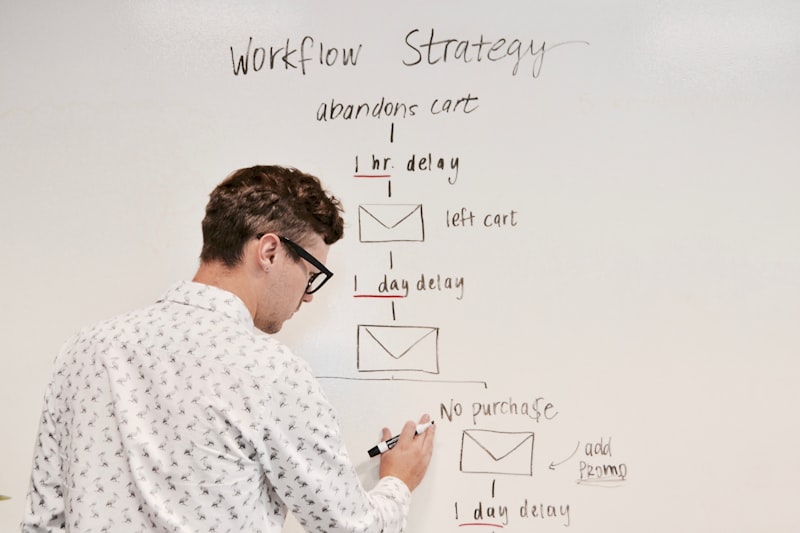So you want to get started with email marketing, but don't know where to begin. I get it—email marketing often feels overwhelming complex to total beginners.
In this complete guide, I'll walk you through how to build an effective email marketing process step-by-step, even if you're starting from scratch.
Why Email Marketing Matters
- Deliver value and build relationships through regular communication
- Most effective channel to drive traffic and sales
- High return on investment compared to other channels
Before we dive into the how-to, let's briefly cover why email marketing deserves your focus and investment.
Email continues to be the most effective channel for engaging your audience and driving conversions. According to Campaign Monitor, email drives 38 times more revenue than Facebook and Twitter combined.
Beyond the numbers, email allows you to regularly deliver value to your subscribers and nurture long-term relationships. Developing this loyalty and trust pays dividends across your business.
Given the immense benefits, dedicating time and resources into building a robust email marketing process is hugely worthwhile, especially for early-stage businesses.
Step 1: Growing Your Audience
You need people to market to. Let's cover proven tactics to grow your mailing list over time.
Opt-in incentives
Offer an ethical bribe for email subscriptions. Free shipping, exclusive content and contests work very well.
Over time these assets will compound to grow your list as they continue circulating the web.
| Incentive | Description |
|---|---|
| Ebooks | In-depth reports on popular topics related to your niche. Provide value, don't overly sell. |
| Webinars | Interactive content that helps establish expertise. Record live Q&As to repurpose. |
| Giveaways | Free merchandise through contests raises brand awareness. |
Website sign-up forms
Place email sign-ups prominently on your website. Pop-ups and sticky bars work best, just avoid being overly aggressive.
Consider offering opt-in incentives (mentioned above) in your forms to boost conversions.
Site navigation
Make it easy for visitors to subscribe. Having clearly labeled forms where people expect helps capture more emails passively.
Social media
Market your opt-in incentives on social channels and run subscription campaigns. Paid ads to cold audiences work very well to expand reach.
Step 2: Email Service Provider
To send emails at scale, you need an email service provider (ESP). They handle deliverability challenges so your emails reliably reach subscriber inboxes.
I recommend ConvertKit for starting out. It has robust automation features wrapped in an intuitive interface.
For high-volume senders, Mailchimp is also popular. Shopify provides default email capabilities for ecommerce stores which is enough for early on.
Key features to look for in an ESP:
- List and contact management: Organize subscribers and segment based on attributes to target campaigns.
- Templates: Professionally designed, mobile responsive templates to showcase your branding.
- Automations: Set up sequences like welcome series and re-engagement flows.
- Analytics: Reports on open, click through and conversion rates help optimize Performance.
- Integrations: Connect your ESP to other tools like your CMS and payment processor.
- Deliverability monitoring: Monitor factors impacting inbox placement and spam scoring.
Step 3: Quality Content
Creating compelling content is how you engage and retain subscribers for the long-run.
Determine what topics provide value to your audience and align with your product offerings.
From there establish a recurring content schedule, varying formats to keep it interesting.
Formats
| Format | Description | Examples |
|---|---|---|
| Educational | Teach through long-form tutorials, case studies and guides | Beginner tutorial, Analyzing X industry trends |
| Entertaining | Provide laughs and amusement through short-form content | Memes, comics, funny video clips |
| Inspiring | Motivate and uplift readers with quotes and stories | Story highlight reels, famous quotes |
| Promotional | Offer deals, sales and site announcements to existing customers | New product releases, seasonal sales |
Mix in surveys and interactive formats like quizzes occasionally to better understand your audience's needs while keeping them engaged.
Step 4: Effective List Building
Quality over quantity rings true in email marketing. Relevancy increases deliverability, open rates and conversions.
With list building your aim is getting subscribers who fit well with your content format and actually want to hear from you.
Here are critical guidelines to follow while keeping lists squeaky clean:
Double opt-in
Require new subscribers to confirm sign ups via verification emails. This filters out bogus leads from fake email generators.
Re-permission stale contacts
If a contact hasn’t engaged in over 6 months, have them reconfirm subscriptions before sending more mail. This reduces list decay from outdated records.
Actively prune
Manually inspect low engagements contacts and remove those clearly not interested anymore. Watch for spam button usage, email kicks backs and social profile checks.
The best practice is maintaining a small but strong list of passionate brand advocates over weakly-attached “junk” contacts from bulk list building tactics.
Step 5: Automate Sequences
Marketing automation is email marketing on growth enhancing steroids.
Automated sequences deliver consistent value through scheduled communication with website visitors and email subscribers.
From welcome series to re-engagement campaigns, these predictable yet personalized emails build trust and affinity with your brand over the mid to long-term.
Let's overview proven sequences that establish lasting customer relationships.
Welcome Series
Welcome new subscribers immediately with useful content tailored to interests. Spread across 3-5 emails delivered over the first week.
Cover goals like introducing your brand, products, resources and community perks.
Educational Series
Expand on popular topics or related products through a recurring educational series. Quality over quantity; consistency being key.
Prepare sequels ahead then schedule these “courses” on calendars or product launches to anticipate need.
Abandoned Browse Sequence
Encourage site visitors to complete a purchase after leaving by reminding them what's in the cart.
Send first email 1 day later then follow ups on days 3 and 7.
Re-engagement Sequence
Win back disengaged subscribers by offering an irresistible resource based on past purchases and interests.
Send sequence if no click activity for 60-90 days.
Milestone Sequence
Show love, appreciation and helpful tips to customers post sign-ups, referrals, renewals, first purchase anniversary and other key milestones.
Boosts retention and brand sentiment with thoughtful touch points.
That covers the start-to-finish process for strategically growing your email subscriber base and keeping them engaged over the long run.
Now the exciting work begins experimenting with these channels and formats to determine what resonates best with your audience. Listen, learn and iterate as you build relationships ripe with trust and reciprocity.
What aspect are you most excited to implement for your email marketing process first? Let me know in the comments!
FAQ
How do I get started building an email marketing process?
If you're new to email marketing and want to improve your process, here are some things you should know before getting started.
Have a goal in mind. Are you trying to convince people to buy your product? Do you want people to sign up for your newsletter? You must have a solid idea of your email's primary benefit, or else your contacts may ignore it completely. You can also have multiple goals: one that focuses on creating awareness about your brand and another that persuades people to purchase from you. Make sure each email has its own purpose so that it doesn't get lost in the shuffle. If a contact unsubscribes from your list because they feel overwhelmed by too many emails, this can be detrimental to maintaining an engaged audience.
Know why you're doing this in the first place. As with any business process, management must understand why certain actions are being taken so they can be held accountable if results don't match expectations or if there is no ROI from their efforts at all.
What's the first step in building an email marketing process?
Once you've decided who you're going to email, the next step is to figure out exactly how to find them. If you're a small business just starting out, this information might already be right at your fingertips. Perhaps you have a customer list in-house; maybe you know your ideal customers personally. If either of these scenarios applies to you, great! Your job is essentially done when it comes to finding people to email.
For everyone else, the process of building an email list is usually one that requires time investment and financial expenditure. And if your organization has been around for several years with solid customer service and content marketing efforts in place—but no formal email strategy—you may need to reassess your approach while simultaneously filling in the blanks of your current system.
What is a lead magnet, and how does it work?
A lead magnet is a piece of content or giveaway that you offer to your website visitors in exchange for their email address. A good lead magnet attracts your ideal customer, solves their problem, and encourages them to take a specific action.
Most importantly, a lead magnet should provide real value to the recipient, regardless of whether they end up becoming a paying customer. The goal is to build trust and demonstrate that you understand their needs and problems (and can help them solve them). In turn, this encourages subscribers to engage with your emails, which helps you develop a relationship with them and nurture them into customers.
How do I build an opt-in form?
In order to build an email marketing process, you're looking to increase opt-in conversions. Opt-ins are important because they determine the ultimate success of your email marketing campaign; so if you can improve this percentage even by just 2 percent, your efforts will be well worth the time and effort.
Here are a few easy steps to take to increase opt-in conversions: Keep in mind that an opt-in form is just another type of call-to-action. You may think that it would be sufficient to just add text and click "send" on a form, but as we learned from feedback in our previous guide, nothing could be further from the truth. The more attention you give to the opt-in form itself and how it's framed, the better its chances of sending more people into your list. So before you start adding functionality or functionality improvements—like language translations and templates—to your forms, make sure that any changes are intentional and appropriate for improving conversion rates.
Where do I put my opt-in form?
Now that you've decided what your opt-in offer will be and have created the form, it's time to put it on your website.
The most effective place to put an email opt-in form is as a pop-up that appears on every page of your website. This way, no matter where visitors go during their experience on your site, they are getting the message. Use the pop-up to offer them something valuable in exchange for their email address (like a downloadable Ebook).
To create this eye-catching effect:
- Include a clear headline explaining precisely what people will get if they enter their information into the email opt-in form.
- Include a visible call to action (CTA) button where people can click to enter their information into the form. Make sure this button stands out from other elements on the page by using bright colors and direction words like "Subscribe" or "Download."
How often should I send emails to my list?
There's no definitive answer to this question—how often you should email your list depends on what your goals are. You probably shouldn't email your list every single day, or even every week, because that would be excessive and annoying. In general, it's best not to over-email your list—you want them to remember who you are and look forward to hearing from you, not forget about you entirely.
If your goal is to build trust with your audience, you can get away with sending emails once a month or so. But if your goal is actually making money (which is probably the case), it might make sense to send emails more frequently than that. How often should you send emails? That's going to vary based on how many subscribers are on your list and how much they like hearing from you (and how much they want what you're selling).
You'll have to experiment a little bit to see what works for you and for the people on your list. It might make sense to send an email once per week at first, but one of these days someone might get sick of getting that many emails from you and unsubscribe—at which point it will make sense for you to slow down a bit and start sending fewer emails.
What types of content should I send to my list?
Now that you've got a list and have figured out how to send emails, what exactly should you be sending?
It's up to you, really! The first thing we're going to say is: try to send 3-5 emails every week. Not *only* sales messages, but 3-5 emails in total. Your subscribers will get a better sense of who you are if they hear from you more often, and they'll be more likely to buy from you.
The next thing we're going to say is: offer value beyond just the sale. Your subscribers might want discounts and promotions, but don't only share those things; show them that there's more for them when they spend time with your brand. Share industry news or research. Make recommendations for other products or services (that aren't yours). What else can you give them?
Last thing we're going to say: mix it up! Try different kinds of content—long form vs short form text articles, video vs audio clips, polls or surveys vs memes or gifs… use your imagination! And don't be afraid to do a little testing on your email list: every month or so, try two different approaches (say a funny GIF versus an article about market trends) and see which one gets the best response from your subscribers.
Do I need to send a welcome email when someone subscribes to my list?
Email marketing is a fundamental part of growing an audience, but it can be tricky because each subscriber has to opt-in to your list before they become a customer or supporter of your brand. When you send out a welcome email, you'll have an open line of communication with that subscriber and the opportunity to start building trust and establish yourself as someone who is worth continuing to hear from. Since subscription emails are viewed by many more people than other marketing emails, it's important to choose the right sequence for when you send out your welcome campaign and any other email messages you may send. Here are two things to keep in mind:
- Use "reminder" emails for subscribers who haven't yet confirmed their subscription. The idea is simple: You're reminding them why they want your content, so let them know what is coming up next.
- Revisit appreciated subscribers periodically with special offers and discounts on new stuff from time to time. If they do not already see these things amongst their inboxes—or if they've unsubscribed—they'll appreciate the reminder that they still need your content!
Building an effective email marketing process takes time but it's worth it.
Don't expect to see overnight results from this process. We understand how hard it is to be patient, but it's important not to give up too early on a process before allowing your customers enough time to respond. Building an effective email marketing process takes time, so be sure that you're committed—but we know that once you do commit, the payoff will be worth all of the effort!






